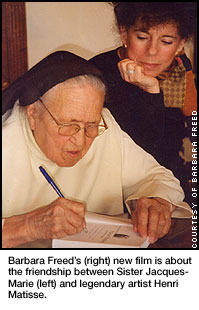|
|
||||
|
|
French Professor Directs "Model for Matisse" � The little-known friendship between a French Dominican nun and legendary 20th-century artist Henri Matisse is the subject of "A Model for Matisse," a documentary film directed by Barbara Freed, professor of french and applied linguistics at Carnegie Mellon.
Author and translator of several books on the artists and museums of Southern France, Freed initiated the documentary project after translating the book Sister Jacques-Marie had written about her longtime friendship with Matisse. "I became enchanted with Sister Jacques-Marie and her wonderful book," Freed said. "It was unpretentious, refreshing and I felt it had to be translated and shared with a broader audience." In 2001, shortly after the 50th-anniversary celebration of the chapel's construction, Freed started the film project with a grant from the Florence Gould Foundation. She spent about a year editing the documentary and did some final filming early this year. The first major screening is scheduled for November at the Matisse Museum in Nice. Monique Bourgeois (as Jacques-Marie was known before joining the Dominican order) was a 21-year-old nursing student and amateur artist living in the coastal city of Nice when, in 1941, she answered Matisse's ad seeking "a young and pretty nurse" to help him cope with multiple ailments. The two developed "a very close and lovely friendship" that would endure for many years, Freed said. Bourgeois posed for many of Matisse's drawings and paintings and accepted his guidance on her own artistic forays. Their paths diverged during World War II, however, when Matisse decided against following artists who were fleeing France in response to coastal bombing threats, but instead took refuge in Vence, a village 20 miles inland from Nice. Around the same time, a tuberculosis scare took Bourgeois to Vence, where she had spent part of her childhood. She was cared for at a Dominican convent, and in 1943 made the decision to join the order of nuns. In 1946 she became Sister Jacques-Marie, and eventually renewed her friendship with a very surprised Matisse. One day, Sister Jacques-Marie showed Matisse a small sketch she had done that illustrated the Assumption, and he encouraged her to turn it into a stained glass window, Freed said. This innocent sketch inspired Matisse to make a long-desired chapel for the Dominican convent a reality. Throughout a four-year period, Sister Jacques-Marie served as liaison between her religious community and Matisse as he designed the Chapelle du Rosaire from top to bottom, including the floors, windows, chairs and even the vestments of the priests. "It's a very, very special place," Freed said. "Matisse considered it the masterpiece of his life's work." The documentary project is also meaningful to Freed, who moved to Vence in the summer of 1960 with her parents, both artists. She was profoundly affected by the time she spent living there exploring the French Riviera, "a small but extraordinary stretch of coast that possesses one of the world's greatest concentrations of modern art and museums. "Matisse had died about six years earlier," Freed said, "but his Chapelle du Rosaire was a living testament to his presence." Through the documentary project, Freed hopes to bring the story of Matisse, his muse and the masterwork chapel to a much broader audience.
"Americans have a longstanding love affair with Matisse," she said. "Although the chapel is well known, the story of how it came to be is not."
Cheryl Valyo
|
||
|
Carnegie Mellon Home |
||||
 The unlikely pair worked together from conception to completion of Matisse's tour de force, the Chapelle du Rosaire (Chapel of the Rosary) in the French village of Vence. Their story is the focus of Freed's compelling new film, the first she has directed.
The unlikely pair worked together from conception to completion of Matisse's tour de force, the Chapelle du Rosaire (Chapel of the Rosary) in the French village of Vence. Their story is the focus of Freed's compelling new film, the first she has directed.